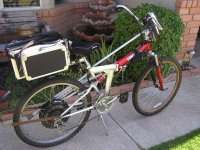Looks like the disc is the right rotation direction; during braking the grip of the calipers would place forces back along the curves of the "spokes" of the disc back to it's mounts, in compression. AFAICR that's how I've seen most discs on bikes and MCs/etc. installed.
If you flip the torque arm 180 degrees, in mirror image of how it is now, would the nuts go on? Alternately, could you use a longer bolt, a spacer tube with thick walls to apply compression to the surface of the arm, and put the nut on the inside of dropouts?
Additionally, you can take the torque washer's tab and bend it down so it is flatter to the axle, so that it sits deeper in what there is of a dropout.
As for whether alloy dropouts will be sufficent, I'd personally rather have a torque plate on there similar to the one someone else recently made, which would actively prevent rotation even if the dropouts failed (and by preventing rotation should prevent dropout failure). Problem about alloy dropouts is you may have no way of knowing if they are already damaged and about to fail until after they already do, as in many cases of alloy part failure I have seen the stress cracks may be under the paint, with the slightly stretchy powdercoating flexing across the crack and not cracking with it, only breaking away after the part has already separated.
Steel bends first before snapping, so you'd probably notice your wheel "felt funny" at high torque before something actually failed.

Plus you'd be able to visually see the dropouts spreading, a little at a time, if you check them each ride, if a problem were developing.
What I would like to do myself on such dropouts, at minimum, is make a clamp that goes in a lazy J from the rackmount accessory point then down behind the axle, then forward under the dropout to a clamp or bolt point in front of the dropout somewhere along the chainstay. That might at least minimize the spreading, although with sufficent torque on the dropout it would require it to be a bolt point forward of the dropout, actually welded to the chainstay, to resist the torque. A clamp would probably just slip.
A torque plate that has an axle-shaped hole in it to prevent rotation, that bolts to the dropouts and the hardpoints for racks/etc, even disc brake caliper mountpoints, would be much better, I think.
If you're not going to hit the throttle hard it won't matter, but if you do, the torque can be a lot higher.


